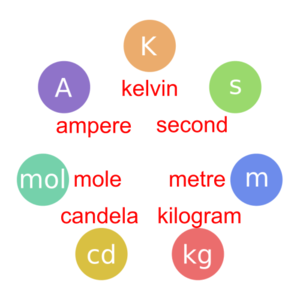Metric System of Measurement: Difference between revisions
From DT Online
(Created page with "300px|right __TOC__ The modern metric system is the [https://en.wikipedia.org/wiki/International_System_of_Units '''International System of Units''']...") |
No edit summary |
||
| Line 34: | Line 34: | ||
Note: that when a unit is named after a person, its abbreviation is given a capital letter but not when written in full - e.g. N and newton, A and ampere. | Note: that when a unit is named after a person, its abbreviation is given a capital letter but not when written in full - e.g. N and newton, A and ampere. | ||
[[Category:Primary]] | |||
[[Category:Topics, Projects and Tasks]] | |||
[[Category:Measuring and Surveying]] | |||
Latest revision as of 22:27, 10 March 2021
The modern metric system is the International System of Units (French: Système International d'Unités, SI). The system was published in 1960 and was based on the metre-kilogram-second system of units (MKS). There are now seven internationally agreed units plus units derived from them to cover all aspects of technology together with a set of prefixes which serve as multipliers or fractions of them.
The idea of Metrication or decimals based units is not new and has obvious attractions with regard to ease of calculation. A Furlong for example was 10 Chains long
By the middle of the 18th Century it had become clear that a simpler and standardised system of measurement was needed to help trade between nations. Around the time of the French Revolution measures of length and weight derived from nature were established, along with their decimal multiples and fractions. This became the standard of France and Europe reference a bars of Platinum was made to set the correct length of a Metre.
Towards the end of the 18th Century James Watt called for a decimal system and in France it was proposed that a Metre could be defined by the length of a pendulum as it beats out 1 second. Unfortunately, this measurement varies a little depending on which country it is done in and although it became standard across Europe both the UK and America were unable to agree to it.
The Metric system continued to be developed and is now based on fundamental constants of nature such as the speed of light in a vacuum. It was formally defined in French law to form the basis of what eventually became the System of Units (SI)’’’ which is the only system of measurement with an official status in nearly every country in the world.
SI Base Units
- The Second (s) is the base unit of time originally based on the Earth's rotation cycle but but this can vary slightly so is now defined by the behaviour of some atoms to give a more constant value.
- The Metre (m) is the base unit of length which at one point was based on measurements of the Earth but is now defined by how far light travels in a vacuum in a set time
- The Kilogram (kg) is the base unit of mass which was originally defined as the mass of one litre of water. This is still quite accurate but now the scientific definition relates it to certain physics constants.
- The Ampere (A) is the base unit of electric current based on the electrical charge carried by certain atoms.
- Kelvin (K) is the base unit of temperature and uses absolute zero as its null point. It is often used in conjunction with the degree Celsius, which has the same magnitude.
- The Mole (mol) is the unit of measurement for amount of substance in a material which is the number of atomic particles. Used mainly by chemists, it is numerically equal to Grams for most practical purposes.
- The Candela (cd) is the base unit of luminous intensity or the amount of light given out. A common wax candle emits light with a luminous intensity of roughly one Candela and is defined using techniques for electromagnetic radiation.
From these 7 Base Units other units can be derived from them and defined by them. For example, a Newton is the measurement of Force given by the mass of a Kilogram when acted on by acceleration due to gravity. For practical purposes, the acceleration due to gravity can be taken as 10m/s2 (should be 9.80665 m/s2) and so a Newton is approximately 10 x 1Kg. An adult weighs roughly 600N.
Prefixes are added to unit names to produce multiples and submultiples of the original unit - e.g. kilometres and millimetres.
Note: that when a unit is named after a person, its abbreviation is given a capital letter but not when written in full - e.g. N and newton, A and ampere.
